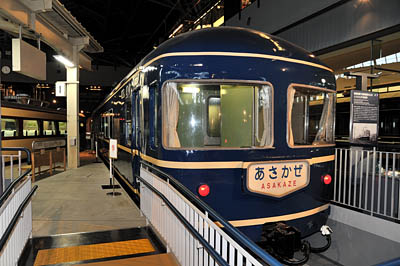
Passenger Car
Class
|
First modern permanently-coupled type passenger car series for night limited express. (Na = Weight 27.5-32.5 ton, Ha = 3rd (later 2nd) passenger class, Ne = Sleeping car, Fu = with Conductor room) |

|
|
When all of the Tokaido main line was electrified during November 1956,
improvement was also needed for Long-Distance trains between Tokyo and Kyushu.
At that point in time, a new modern long distance model of Electric-Multiple car was being developed.
(Consult please Series-151).
This new passenger car series also developed a totally new design idea. Traditionally, locomotive unpowered trailer vehicles were designed to be coupled to any other car. However, the new passenger car was planned from a different concept, a permanently-coupled passenger unit would be used on the same as the Electric-Multiple unit.
The new Series-20 passenger car unit was completed during 1958 from this basic idea. The Series-20 was especially designed for a diesel generator equipped ONE-POWER-SUPPLY car. All train units electricity ..... air-conditioning, heating equipment, illumination, dining cars etc... were provided from this power supply car. The permanently-coupled unit design made it possible. The brown colored traditional passenger car color was changed to a cool blue color with a white line. Afterward, this coloration became the standard color for Japan's night trains, and they were called "Blue Trains". They were also called "Running Hotels" because of their luxurious look at their debut time. During 1958, the first appearing Series-20 units had a total of thirteen permanently-coupled cars. They were ; 1st class roomette type sleeping car Class NaRoNe-20, 1st class sleeping car NaRoNe-21, 1st class seat car NaRo-20, 2nd class seat car NaHa-20, 2nd class with a selling booth sleeping car NaHaNe-20, 2nd class seated with a conductor room and an small observation room car NaHaFu-20, Dining car NaShi-20, Power room with luggage room car MaNi-20.
All of the above cars had air-condiioning, even though air conditioning was not found in Japanese homes at that time. Also, single-bed roomette sleeping cars were seen for the first time in Japan. The first Series-20 unit began as the limited express "Asakaze (morning breeze)" between Tokyo and Hakata (Fukuoka) from October 1958. A total of thirty-seven Series-20s were manufactured during the first year.
Since "Asakaze" gained such popularity, during the next year of 1959, more Series-20 were manufactured for a total of thirty-four as limited express "Sakura (cherry)". During 1960, thirty-nine Series-20 were manufactured as the "Hayabusa (falcon)" with a power collector pantograph equipped power supply car Class KaNi-22. Afterward, Series-20 not only ran on the Tokyo, Osaka, to Kyushu run, but also from Tokyo to the northern part of Tohoku. Series-20 were finally manufactured in 16 classses consisting of 473 cars up to 1970.
However, Series-20 became obsolete from the late 1970s. So, they were not only operated as limited express, but also operated as express or irregular trains. During October 1980 they were retired from regular limited express service with the last running "Akebono (dawn)" train between Ueno, Akita and then to Aomori. During November 1986, all were retired from regular express operations. With the privatization of the JNR during 1987, 97 Series-20 survived, and of these, 34 were transferred to the JR-East and 63 were transferred to the JR-West, and were used as irregular trains. On the 29th of November 1997, the "Sayonara (good-bye) Series-20 " train ran between Shin-Osaka and Okayama on the Sanyo line on JR-West, and a goodbye ceremony was held at the Shin-Osaka station, and Series-20 were retired from all operations from that day on.
|
|
Preserved Class NaHaNeFu-22 No.1 (1964 - 1986)
The first NaHaNeFu-22 was manufactured at the Nippon-Sharyo Co. on the 15th of May 1964. After its appearance, the NaHaNeFu22-1 was deployed to Shinagawa depot and was active in the Tokyo and Kyushu's limited express service. During 1970-1971, she was transferred to the Mukomachi (Kyoto) depot and was used on the Osaka - Kyushu limited express service for a brief time, but during the next year of 1971, she was moved to the Aomori depot and was used on the Tohoku and Jyoban line's limited express "Yuzuru (crane in the dusk)" etc .... During 1973 she was transferred to the Oku depot in Tokyo and continuously used in the Tohoku area. Later she was demoted for express operation, and was retired during March 1986. After retirement, she was kept at the JNR Ofuna workshop (later JR-East Kamakura General Rolling Stock Center, Fukazawa) for a long time. On the 31st of March 2006, she was moved to the Omiya General Rolling Stock Center from the Ofuna Center (due to it's closing). NaHaNeFu22-1 was remade at the Omiya Center, and was exhibited at the Saitama Museum from October 2007. |
Introduction |
Go to Top |